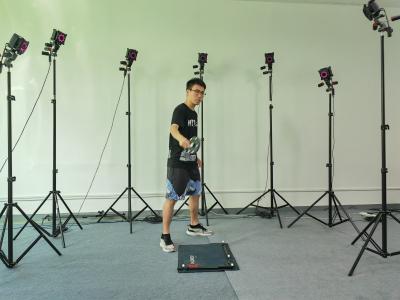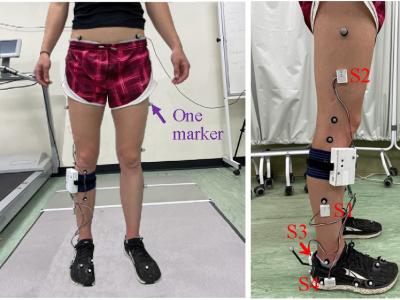Wearable Sensing

this is dataset of sEMG. raw data include four columns, which are channel 1, channel 2, channel 3, and the reference channel. corresponding thesis proposes the integration of a dynamic time regularization algorithm to enhance gesture recognition detection accuracy and real-time system performance. The application of the dynamic time warping algorithm allows the fusion of three sEMG signals, enabling the calculation of similarity between the sample and the model.
- Categories:
 54 Views
54 Views
The morphological characteristics of skeletal muscles, such as fascicle orientation, fascicle length, and muscle thickness, contain valuable mechanical information that aids in understanding muscle contractility and excitation due to commands from the central nervous system. Ultrasound (US) imaging, a non-invasive measurement technique, has been employed in clinical research to provide visualized images that capture morphological characteristics. However, accurately and efficiently detecting the fascicle in US images is challenging.
- Categories:
 214 Views
214 Views
<p> The dataset is digital health data. It contains heart rate data extracted from Fitbit version 2 smartwatch worn by a healthy male Asian person of 48 years old. Data is of one-month duration. We have uploaded a zip file that contains data from different days. Data for each day has a separate file. The file name contains the date. Each file is in csv format. Each file has two columns – timestamp and heart rate. It is a continuous time-series heart rate data. Heart rate was recorded seamlessly at 5 sec interval. However, there may be missing datum.
- Categories:
 3470 Views
3470 Views
8-channel monopolar sEMG signals were acquired using the device developed by our research group at a sampling rate of 1000 Hz. Medical gel electrodes (CH50B, Shanghai Hanjie Electronic Technology Co., LTD., Shanghai, China) were used for data collection. The position of the electrodes is shown in Fig. 2. The REF electrode was placed on the inner side of the upper big arm near the elbow and the RLD electrode was placed on the outer side of the right upper arm near the elbow. Eight monopolar electrodes were placed on the right forearm.
- Categories:
 125 Views
125 ViewsThe project research team successfully established China's first Inertial Motion Tracking Dataset (IMTD), which can be widely used for artificial intelligence model training in fields such as satellite-free navigation, unmanned driving, and wearable devices. Based on the IMTD dataset, the motion tracking method proposed by Wang Yifeng, Zhao Yi, and others breaks through the limitations of traditional motion tracking and positioning technologies such as inertia, optics, GPS, and carrier phase.
- Categories:
 346 Views
346 Views
A challenge with how the body processes sensory information is one of the most important behavioral signs of autistic people. This is usually manifested as being either overly sensitive or underly sensitive to touch. To address this anomaly, many researchers have proposed wearable sensor-based systems and applications in the field of virtual environments but have neglected to conduct a proper evaluation and proof of concept for autistic people.
- Categories:
 123 Views
123 ViewsElectromyography (EMG) has limitations in human machine interface due to disturbances like electrode-shift, fatigue, and subject variability. A potential solution to prevent model degradation is to combine multi-modal data such as EMG and electroencephalography (EEG). This study presents an EMG-EEG dataset for enhancing the development of upper-limb assistive rehabilitation devices. The dataset, acquired from thirty-three volunteers without neuromuscular dysfunction or disease using commercial biosensors is easily replicable and deployable.
- Categories:
 2720 Views
2720 ViewsIMUs have gained popularity for tracking joint kinematics due to their portability and versatility. However, challenges such as limited accuracy, lack of real-time data analysis, and complex sensor-to-segment calibration procedures have hindered their widespread use. To address these limitations, we developed a portable system that integrates four IMUs to collect treadmill walking data, with ground truth values obtained from a Motion Capture System.
- Categories:
 127 Views
127 ViewsThis dataset provides valuable insights into hand gestures and their associated measurements. Hand gestures play a significant role in human communication, and understanding their patterns and characteristics can be enabled various applications, such as gesture recognition systems, sign language interpretation, and human-computer interaction. This dataset was carefully collected by a specialist who captured snapshots of individuals making different hand gestures and measured specific distances between the fingers and the palm.
- Categories:
 1089 Views
1089 Views
This dataset is associated with the manuscript entitled "Data-efficient Human Walking Speed Intent Inference". The data represent the measurements taken from 15 able-bodied human subjects as the made speed changes while walking on a treadmill. Each subject is associated with a .mat file that contains 8 variables. Four variables are associated with the training dataset while four are associated with the experimental testing protocol.
- Categories:
 123 Views
123 Views


